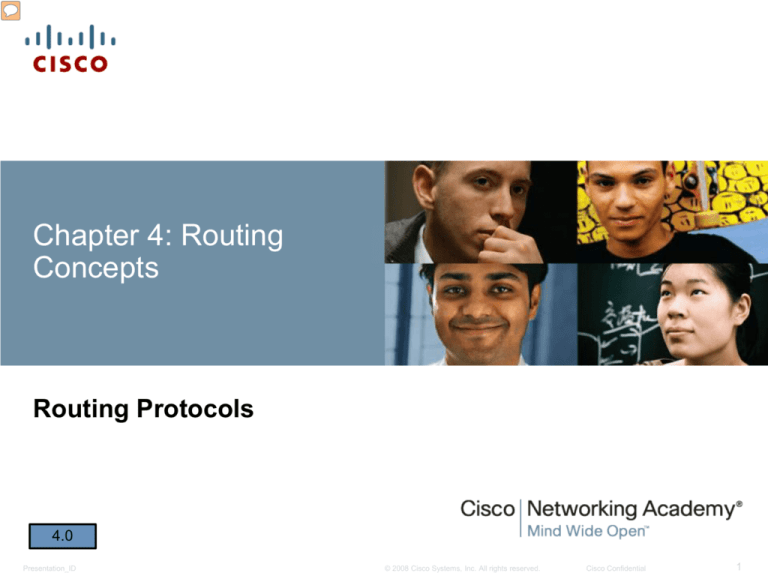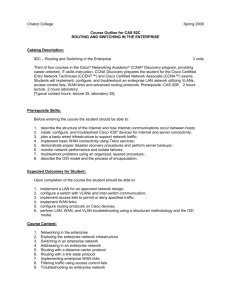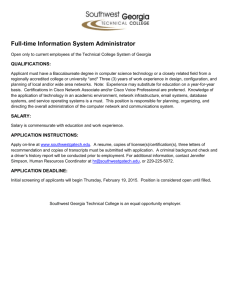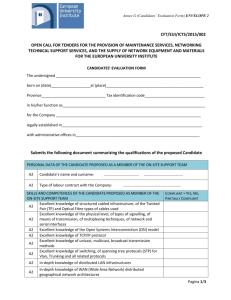
Chapter 4: Routing
Concepts
Routing Protocols
4.0
Presentation_ID
© 2008 Cisco Systems, Inc. All rights reserved.
Cisco Confidential
1
Chapter 4
4.0 Routing Concepts
4.1 Initial Configuration of a Router
4.2 Routing Decisions
4.3 Routing Operation
4.4 Summary
4.0
Presentation_ID
© 2008 Cisco Systems, Inc. All rights reserved.
Cisco Confidential
2
Chapter 4: Objectives
Configure a router to route between multiple directly connected
networks
Describe the primary functions and features of a router.
Explain how routers use information in data packets to make
forwarding decisions in a small to medium-sized business network.
Explain the encapsulation and de-encapsulation process used by
routers when switching packets between interfaces
Compare ways in which a router builds a routing table when
operating in a small to medium-sized business network.
Explain routing table entries for directly connected networks.
Explain how a router builds a routing table of directly connected
networks.
4.0
Presentation_ID
© 2008 Cisco Systems, Inc. All rights reserved.
Cisco Confidential
3
Chapter 4: Objectives (continued)
Explain how a router builds a routing table using static routes.
Explain how a router builds a routing table using a dynamic routing
protocol.
4.0
Presentation_ID
© 2008 Cisco Systems, Inc. All rights reserved.
Cisco Confidential
4
Functions of a Router
Characteristics of a Network
4.1.1.1
Presentation_ID
© 2008 Cisco Systems, Inc. All rights reserved.
Cisco Confidential
5
Functions of a Router
Why Routing?
The router is responsible for the routing of traffic
between networks.
4.1.1.2
Presentation_ID
Do animation on 4.1.1.2
© 2008 Cisco Systems, Inc. All rights reserved.
Cisco Confidential
6
Functions of a Router
Routers are Computers
Routers are specialized computers containing the
following required components to operate:
Central processing unit (CPU)
Operating system (OS) - Routers use Cisco IOS
Memory and storage (RAM, ROM, NVRAM, Flash, hard drive)
Routers utilize the following memory:
4.1.1.3
Presentation_ID
Do buttons on 4.1.1.3
© 2008 Cisco Systems, Inc. All rights reserved.
Cisco Confidential
7
Functions of a Router
Routers are Computers
Routers use specialized ports and network interface
cards to interconnect to other networks
4.1.1.3
Presentation_ID
© 2008 Cisco Systems, Inc. All rights reserved.
Cisco Confidential
8
Functions of a Router
Routers Interconnect Networks
Routers can connect multiple networks.
Routers have multiple interfaces, each on a different IP
network.
4.1.1.4
Presentation_ID
Do Animation and Buttons on 4.1.1.4
© 2008 Cisco Systems, Inc. All rights reserved.
Cisco Confidential
9
Functions of a Router
Routers Choose Best Paths
Determine the best path to send packets
Uses its routing table to determine path
Forward packets toward their destination
Forwards packet to interface indicated in routing table.
Encapsulates the packet and forwards out toward
destination.
Routers use static routes and dynamic routing
protocols to learn about remote networks and build
their routing tables.
4.1.1.5
Presentation_ID
Do Animation on 4.1.1.5
© 2008 Cisco Systems, Inc. All rights reserved.
Cisco Confidential
10
Functions of a Router
Routers Choose Best Paths
4.1.1.5
Presentation_ID
© 2008 Cisco Systems, Inc. All rights reserved.
Cisco Confidential
11
Functions of a Router
Packet Forwarding Methods
Process switching – An older
packet forwarding mechanism
still available for Cisco routers.
Fast switching – A common
packet forwarding mechanism
which uses a fast-switching
cache to store next hop
information.
Cisco Express Forwarding
(CEF) – The most recent,
fastest, and preferred Cisco
IOS packet-forwarding
mechanism. Table entries are
not packet-triggered like fast
switching but change-triggered.
4.1.1.6
Presentation_ID
© 2008 Cisco Systems, Inc. All rights reserved.
Cisco Confidential
12
Functions of a Router
4.1.1.7 Activity - Identify Router Components
Students do activities on buttons 1, 2 on 4.1.1.7 in class
4.1.1.7
Presentation_ID
© 2008 Cisco Systems, Inc. All rights reserved.
Cisco Confidential
13
Connect Devices
Connect to a Network
4.1.2.1
Presentation_ID
© 2008 Cisco Systems, Inc. All rights reserved.
Cisco Confidential
14
Connect Devices
Default Gateways
To enable network access
devices must be configured
with the following IP address
information
IP address - Identifies
a unique host on a
local network.
Subnet mask Identifies the host’s
network subnet.
Default gateway Identifies the router a
packet is sent to to
when the destination is
not on the same local
network subnet.
4.1.2.2
Presentation_ID
© 2008 Cisco Systems, Inc. All rights reserved.
Cisco Confidential
15
Connect Devices
Document Network Addressing
Network Documentation should include at least the following in a
topology diagram and addressing table:
Device names
Interfaces
IP addresses and
subnet mask
Default gateways
4.1.2.3
Presentation_ID
© 2008 Cisco Systems, Inc. All rights reserved.
Cisco Confidential
16
Connect Devices
Enable IP on a Host
Statically Assigned IP address – host is manually
assigned the IP address, subnet mask and default
gateway. DNS server IP address can also be
assigned.
Used to identify specific network resources such as network
servers and printers
Can be used in very small networks with few hosts.
Dynamically Assigned IP Address – IP Address
information is dynamically assigned by a server using
Dynamic Host Configuration Protocol (DHCP)
Most hosts acquire their IP address information through
DHCP
DHCP services can be provided by Cisco routers
4.1.2.4
Presentation_ID
Do buttons on 4.1.2.4
© 2008 Cisco Systems, Inc. All rights reserved.
Cisco Confidential
17
Connect Devices
Device LEDs
4.1.2.5
Presentation_ID
© 2008 Cisco Systems, Inc. All rights reserved.
Cisco Confidential
18
Connect Devices
Console Access
Console access
requires:
Console cable – RJ-45to-DB-9 console cable
Terminal emulation
software – Tera Term,
PuTTY, HyperTerminal
4.1.2.6
Presentation_ID
Do buttons on 4.1.2.6
© 2008 Cisco Systems, Inc. All rights reserved.
Cisco Confidential
19
Connect Devices
Enable IP on a Switch
Network infrastructure
devices require IP
addresses to enable
remote management.
On a switch the
management IP
address is assigned on
a virtual interface
Do buttons on 4.1.2.7,
Students do practice on button 2
4.1.2.7
Presentation_ID
© 2008 Cisco Systems, Inc. All rights reserved.
Cisco Confidential
20
Functions of a Router
4.1.2.8 Activity - Document an Addressing Scheme
Students do activity on 4.1.2.8 in class
4.1.2.8
Presentation_ID
© 2008 Cisco Systems, Inc. All rights reserved.
Cisco Confidential
21
Basic Settings on a Router
Configure Basic Router Settings
Basics tasks that should be first configured on a Cisco Router and
Cisco Switch:
Name the device – Distinguishes it from other routers
Secure management access – Secures privileged EXEC, user
EXEC, and Telnet access, and encrypts passwords to their
highest level
Configure a banner – Provides legal notification of
unauthorized access.
Do buttons on 4.1.3.1
4.1.3.1
Presentation_ID
Students do button 5 in class
© 2008 Cisco Systems, Inc. All rights reserved.
Cisco Confidential
22
Basic Settings on a Router
Configure Router Interfaces
To be available a router
interface must be:
Configured with an
address and subnet mask .
Activated – by default LAN
and WAN interfaces are not
activated. Must be activated
using no shutdown
command.
Other parameters - serial
cable end labeled DCE must
be configured with the clock
rate command.
Optional description can be
included.
4.1.3.2
Presentation_ID
Do buttons on 4.1.3.2
Students do button 4 in class
© 2008 Cisco Systems, Inc. All rights reserved.
Cisco Confidential
23
Basic Settings on a Router
Configure an IPv6 Router Interface
Configure interface with IPv6
address and subnet mask. Use
the ipv6 address ipv6-address/ipv6length [link-local | eui-64]interface
configuration command.
Activate – using no shutdown
command.
IPv6 interfaces can support more than
one address:
Configure a specified global unicast ipv6-address /ipv6-length
Configure a global IPv6 address with
an interface identifier (ID) in the loworder 64 bits - ipv6-address /ipv6length eui-64
Configure a link-local address - ipv6address /ipv6-length link-local
4.1.3.3
Presentation_ID
Do buttons on 4.1.3.3
Students do button 6 in class
© 2008 Cisco Systems, Inc. All rights reserved.
Cisco Confidential
24
Basic Settings on a Router
Configure a Loopback Interface
Loopback interface is a
logical interface internal to
the router.
It is not assigned to a
physical port, it is
considered a software
interface that is
automatically in an UP
state.
Useful for testing and
important in the OSPF
routing process.
4.1.3.4
Presentation_ID
© 2008 Cisco Systems, Inc. All rights reserved.
Cisco Confidential
25
Verify Connectivity of Directly Connected Networks
Verify Interface Settings
Show commands to verify
operation and
configuration of interface.
show ip interfaces brief
show ip route
show running-config
Show commands to gather
more detailed interface
information.
show interfaces
show ip interfaces
4.1.4.1
Presentation_ID
Do buttons on 4.1.4.1
Students do buttons 4,5 in class (briefly)
© 2008 Cisco Systems, Inc. All rights reserved.
Cisco Confidential
26
Verify Connectivity of Directly Connected Networks
IP6 -Verify Interface Settings
show ipv6 interface brief displays a summary for each
of the interfaces.
show ipv6 interface
gigabitethernet 0/0 displays the interface status
and all the IPv6 addresses for
this interface.
show ipv6 route - verify
that IPv6 networks and
specific IPv6 interface
addresses have been
installed in the IPv6 routing
table.
show interface
show ipv6 routers
4.1.4.2
Presentation_ID
Do buttons on 4.1.4.2
© 2008 Cisco Systems, Inc. All rights reserved.
Cisco Confidential
27
Verify Connectivity of Directly Connected Networks
Filter Show Command Output
Use the terminal lengthnumbercommand to specify the number of lines to
be displayed. A value of 0 (zero) prevents the router from pausing between
screens of output.
To filter specific output of commands use the (|)pipe character after show
command. Parameters that can be used after pipe include:
section, include, exclude, begin
4.1.4.3
Presentation_ID
Do buttons on 4.1.4.3
Students do buttons 5 in class (briefly)
© 2008 Cisco Systems, Inc. All rights reserved.
Cisco Confidential
28
Verify Connectivity of Directly Connected Networks
Command History Feature
Recall commands – Ctrl+P or the UP Arrow
To return to more recent commands –Ctrl+N or Down
Arrow
Command history is enabled and captures the last 10
commands in buffer – show history displays contents
Use terminal history size to increase or decrease size
of the buffer.
4.1.4.4
Presentation_ID
© 2008 Cisco Systems, Inc. All rights reserved.
Cisco Confidential
29
Switching Packets between Networks
Router Switching Functions
4.2.1.1
Presentation_ID
© 2008 Cisco Systems, Inc. All rights reserved.
Cisco Confidential
30
Switching Packets between Networks
Send a Packet
4.2.1.2
Presentation_ID
Do animation on 4.2.1.2
© 2008 Cisco Systems, Inc. All rights reserved.
Cisco Confidential
31
Switching Packets between Networks
Forward to the Next Hop
4.2.1.3
Presentation_ID
Do animation on 4.2.1.3
© 2008 Cisco Systems, Inc. All rights reserved.
Cisco Confidential
32
Switching Packets between Networks
Packet Routing
4.2.1.4
Presentation_ID
Do animation on 4.2.1.4
© 2008 Cisco Systems, Inc. All rights reserved.
Cisco Confidential
33
Switching Packets between Networks
Reach the Destination
4.2.1.5
Presentation_ID
Do animation on 4.2.1.5
© 2008 Cisco Systems, Inc. All rights reserved.
Cisco Confidential
34
Switching Packets between Networks
4.2.1.6 Activity - Match Layer 2 and Layer 3
Addressing
Do Activity buttons on 4.2.1.6
4.2.1.6
Presentation_ID
© 2008 Cisco Systems, Inc. All rights reserved.
Cisco Confidential
35
Path Determination
Routing Decisions
4.2.2.1
Presentation_ID
© 2008 Cisco Systems, Inc. All rights reserved.
Cisco Confidential
36
Path Determination
Best Path
Best path is selected by a routing protocol based on the
value or metric it uses to determine the distance to
reach a network.
A metric is the value used to measure the distance to a
given network.
Best path to a network is the path with the lowest metric.
Dynamic routing protocols use their own rules and
metrics to build and update routing tables for example:
Routing Information Protocol (RIP) - Hop count
Open Shortest Path First (OSPF) - Cost based on cumulative
bandwidth from source to destination
Enhanced Interior Gateway Routing Protocol (EIGRP) Bandwidth, delay, load, reliability
4.2.2.2
Presentation_ID
Do animation on 4.2.2.2
© 2008 Cisco Systems, Inc. All rights reserved.
Cisco Confidential
37
Path Determination
Load Balancing
When a router has two or more paths to a destination
with equal cost metrics, then the router forwards the
packets using both paths equally.
4.2.2.3
Presentation_ID
Do animation on 4.2.2.3
© 2008 Cisco Systems, Inc. All rights reserved.
Cisco Confidential
38
Path Determination of the route
Administrative Distance
If multiple paths to a destination are configured on a
router, the path installed in the routing table is the one
with the best Administrative Distance (AD).
Administrative Distance is the “trustworthiness”
The Lower the AD the more trustworthy the route.
4.2.2.4
Presentation_ID
© 2008 Cisco Systems, Inc. All rights reserved.
Cisco Confidential
39
Path Determination of the routere
4.2.2.5 Activity - Order the Steps in the Packet Forwarding Process
4.2.2.5
Presentation_ID
Students do activities on buttons 1 - 4 on 4.2.2.5 in class
© 2008 Cisco Systems, Inc. All rights reserved.
Cisco Confidential
40
The Routing Table
The Routing Table
Routing Table is a file stored in RAM that contains
information about
Directly Connected Routes
Remote Routes
Network or Next hop Associations
4.3.1.1
Presentation_ID
© 2008 Cisco Systems, Inc. All rights reserved.
Cisco Confidential
41
The Routing Table
Routing Table Sources
Show ip route command is used to display the contents
of the routing table
Link local Interfaces –Added to the routing table when
an interface is configured. (displayed in IOS 15 or newer)
Directly connected interfaces -Added to the routing
table when an interface is configured and active.
Static routes - Added when a route is manually
configured and the exit interface is active.
Dynamic routing protocol - Added when EIGRP or
OSPF are implemented and networks are identified.
4.3.1.2
Presentation_ID
© 2008 Cisco Systems, Inc. All rights reserved.
Cisco Confidential
42
The Routing Table
Routing Table Sources
4.3.1.2
Presentation_ID
© 2008 Cisco Systems, Inc. All rights reserved.
Cisco Confidential
43
The Routing Table
Remote Network Routing Entries
Interpreting the entries in the routing table.
4.3.1.3
Presentation_ID
© 2008 Cisco Systems, Inc. All rights reserved.
Cisco Confidential
44
Router Operation
4.3.1.4 Activity- Interpret the Content of a Routing Table Entry
Students do activity on 4.3.1.4 in class
4.3.1.4
Presentation_ID
© 2008 Cisco Systems, Inc. All rights reserved.
Cisco Confidential
45
Directly Connected Routes
Directly Connected Interfaces
A newly deployed router, without any configured interfaces,
has an empty routing table.
An active, configured directly connected interface creates two
routing table entries Link Local (L) and Directly Connected (C)
4.3.2.2
Presentation_ID
© 2008 Cisco Systems, Inc. All rights reserved.
Cisco Confidential
46
Directly Connected Routes
Directly Connected Examples
4.3.2.3
Presentation_ID
Students do activity on buttons 5 on 4.3.2.3 in class
© 2008 Cisco Systems, Inc. All rights reserved.
Cisco Confidential
47
Directly Connected Routes
Directly Connected IPv6 Example
The show ipv6 route command shows the ipv6 networks
and routes installed in the routing table
Do buttons on 4.3.2.4
4.3.2.4
Presentation_ID
© 2008 Cisco Systems, Inc. All rights reserved.
Cisco Confidential
48
Statically Learned Routes
Static Routes
Manually configured
Define an explicit path between two networking devices.
Must be manually updated if the topology changes.
Benefits include improved security and control of
resources.
Static route to a specific network.
ip routenetworkmask {next-hop-ip | exit-intf}
Default Static Route used when the routing table does not
contain a path for a destination network.
ip route 0.0.0.0 0.0.0.0 {exit-intf | next-hop-ip
4.3.3.1
Presentation_ID
© 2008 Cisco Systems, Inc. All rights reserved.
Cisco Confidential
49
Statically Learned Routes
Static Routes Example
4.3.3.2
Presentation_ID
Students do activities on buttons 3,4 on 4.3.3.2 in class
© 2008 Cisco Systems, Inc. All rights reserved.
Cisco Confidential
50
Statically Learned Routes
Static IPv6 Routes Example
Do buttons on 4.3.3.3
4.3.3.3
Presentation_ID
© 2008 Cisco Systems, Inc. All rights reserved.
Cisco Confidential
51
Dynamic Routing Protocols
Dynamic Routing
Used by routers to share information about the
reachability and status of remote networks.
Performs network discovery and maintaining routing
tables.
4.3.4.1
Presentation_ID
© 2008 Cisco Systems, Inc. All rights reserved.
Cisco Confidential
52
Dynamic Routing Protocols
IPv4 Routing Protocols
Cisco ISR routers can support a variety of dynamic IPv4
routing protocols including:
EIGRP – Enhanced Interior Gateway Routing Protocol
OSPF – Open Shortest Path First
IS-IS – Intermediate System-to-Intermediate System
RIP – Routing Information Protocol
4.3.4.2
Presentation_ID
© 2008 Cisco Systems, Inc. All rights reserved.
Cisco Confidential
53
Dynamic Routing Protocols
IPv4 Routing Protocols
4.3.4.3
Presentation_ID
© 2008 Cisco Systems, Inc. All rights reserved.
Cisco Confidential
54
Dynamic Routing Protocols
IPv6 Routing Protocols
Cisco ISR routers can support a variety of dynamic IPv6
routing protocols including:
RIPng (RIP next generation)
OSPF v3
EIGRP for IPv6
MP-BGP4 (Multicast Protocol-Border Gateway Protocol)
4.3.4.4
Presentation_ID
© 2008 Cisco Systems, Inc. All rights reserved.
Cisco Confidential
55
Dynamic Routing Protocols
IPv6 Routing Protocols
4.3.4.5
Presentation_ID
© 2008 Cisco Systems, Inc. All rights reserved.
Cisco Confidential
56
Ta Da!
Presentation_ID
© 2008 Cisco Systems, Inc. All rights reserved.
Cisco Confidential
57








